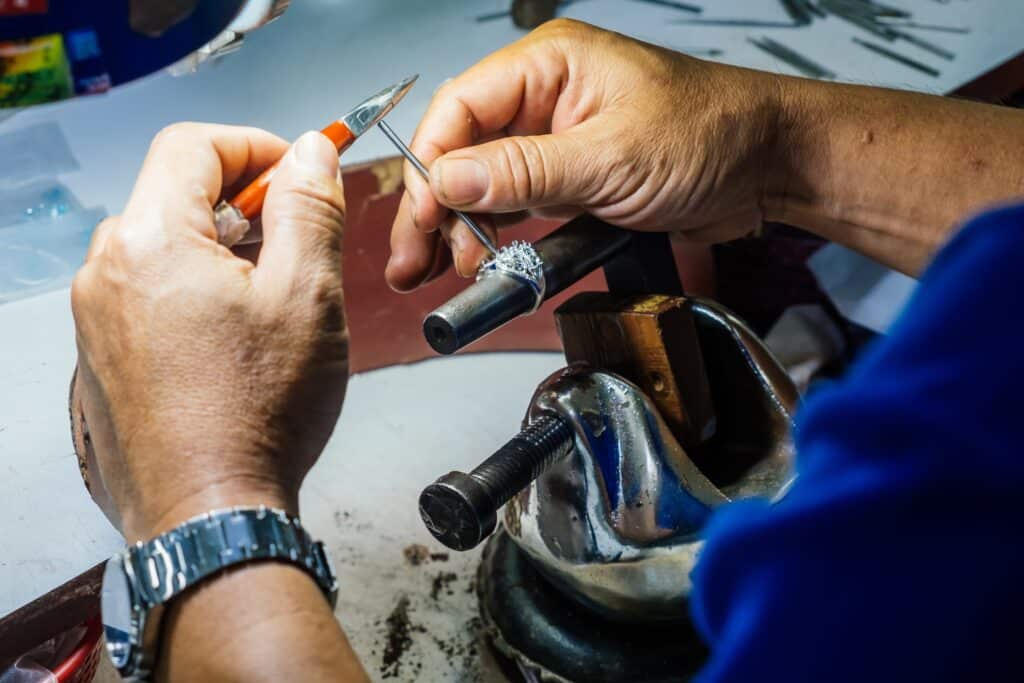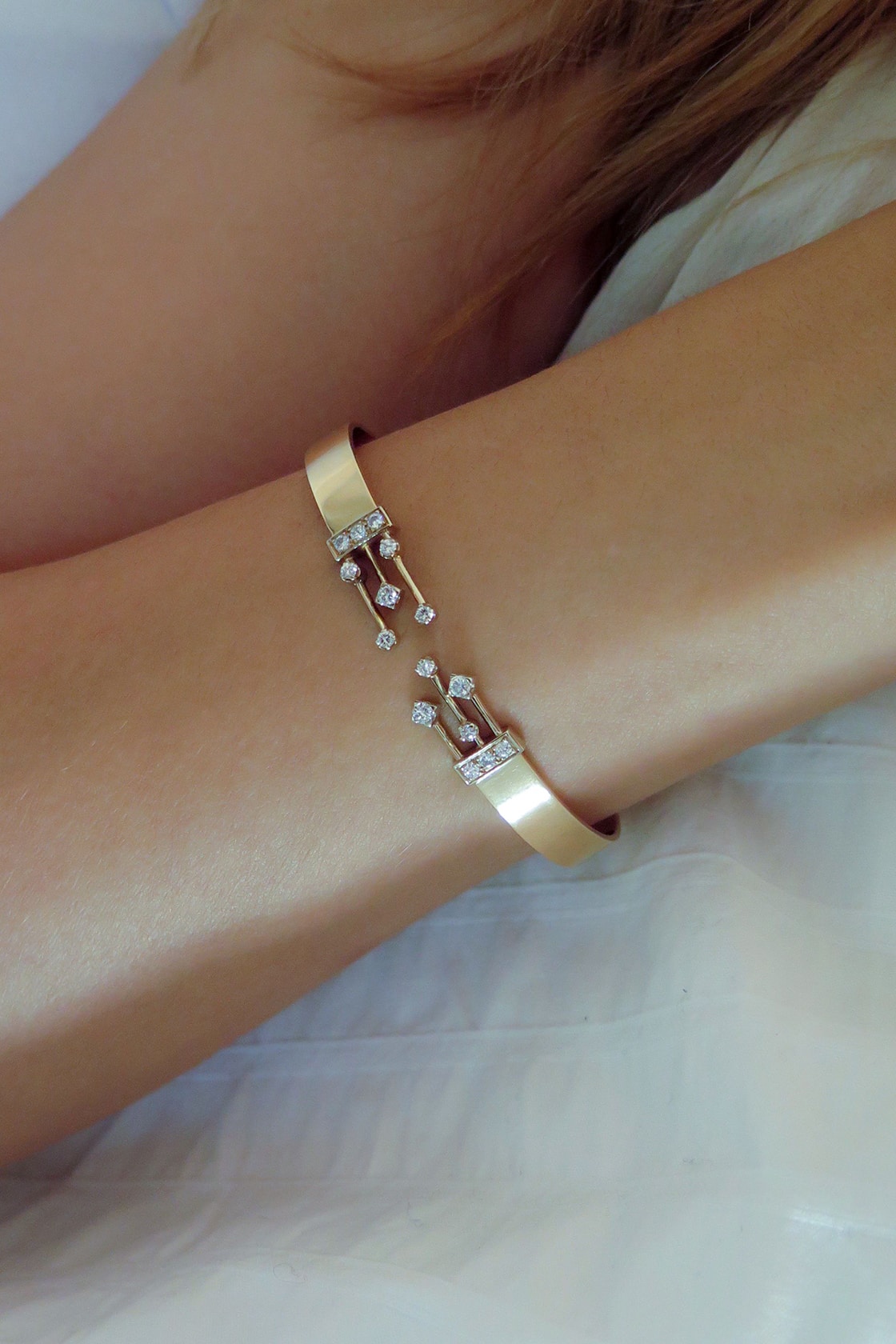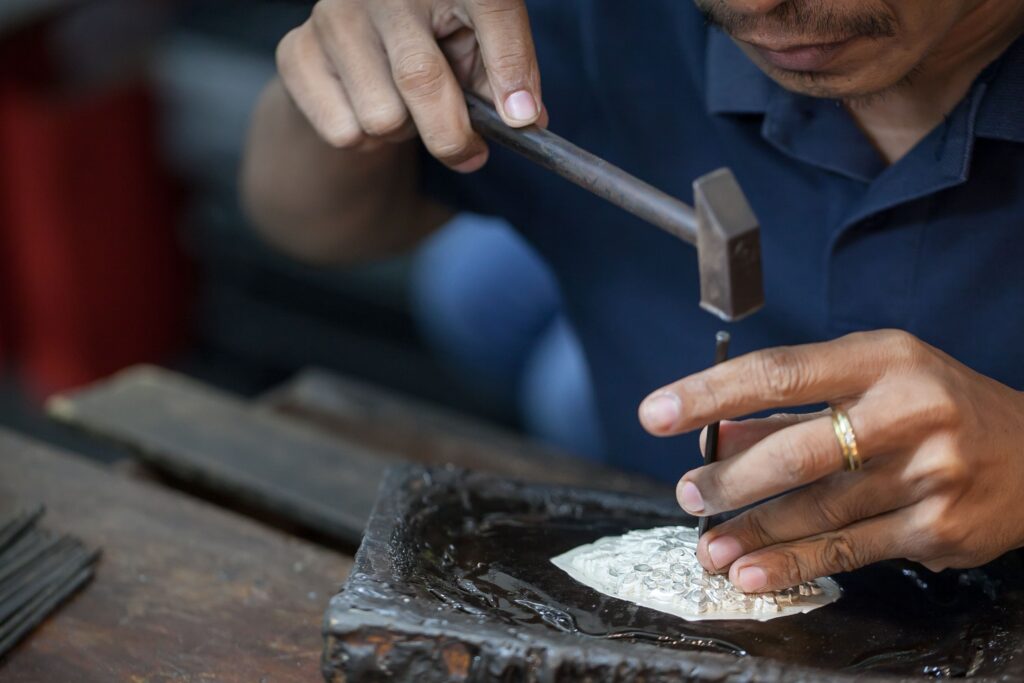Blog
The profession of luxury jeweler: a passion passed down through the centuries
For centuries, luxury jewelry has captivated and drawn admiring glances. Born from the union of art, craftsmanship, and precious materials, it transcends the body and tells stories through its sparkling allure.
Since antiquity, civilizations have adorned their bodies with precious ornaments, symbols of power and prestige. Over the centuries, the craft of the jeweler has evolved, adapting to new techniques and artistic trends. From medieval goldsmithing to Art Deco jewelry, each era has left its mark on this refined art.
At Atelier Bravig, a jeweler in Luxembourg, luxury jewelry is above all a passion passed down from generation to generation. It’s the driving force behind the skilled hands of artisans and guides their creativity. Within the intimacy of the workshop, this ancestral expertise endures, where every precise gesture breathes life into unique creations.
Luxury jewelry: what is a luxury jeweler?
A luxury jeweler is an artisan who crafts exceptional jewelry using precious materials and refined techniques. This profession demands a perfect mastery of the art of jewelry-making, boundless creativity, and a keen attention to detail.
The luxury jeweler primarily works with gemstones and noble metals such as gold, platinum, and silver. Carefully selecting materials, they ensure their quality and origin. Subsequently, various techniques are employed to transform these materials into unique and refined luxury jewelry pieces.

The expertise of a luxury jeweler is unparalleled. They dedicate hours to carving, setting, and polishing each stone, aiming to create a piece that is both aesthetically pleasing and durable. Moreover, they possess the ability to craft custom pieces, meeting the demands and dreams of their clients.
A luxury jeweler is also a passionate artist who expresses creativity through their jewelry. Drawing inspiration from current trends, art history, and nature, they fashion original and timeless pieces. Driven by a love for gemstones, a luxury jeweler pours their heart into the creation of each unique piece.
The stages of creation in luxury jewelry
The creation of a luxury jewel is a complex and fascinating process that blends artisanal expertise with artistic innovation. Each step requires exceptional craftsmanship and meticulous attention to detail.

- Inspiration
The first step begins with inspiration drawn from various sources: trends, history, art, nature, travels, dreams, etc. It is crucial for the jeweler to be passionate about their work and to have a clear vision of what they want to create.
- Design
Once the jeweler has found their inspiration, they begin to sketch the jewel. This could involve quick sketches or more detailed drawings. This step defines the proportions of the jewel, the arrangement of stones, and the techniques that will be used.
- Modeling
Next, the jeweler creates a wax model or utilizes digital techniques to bring their concept to life. This model helps in understanding proportions and details before moving on to the material selection phase. Modeling can be done by hand or with the assistance of software.
- Material Selection
The jeweler then selects the gemstones and metals that will be used to create the jewel. It’s important to choose high-quality materials that align with the jewel’s aesthetic and the client’s budget.
- Setting
Setting is the most delicate step in creating a jewel. It involves securing the gemstones onto the metal. The jeweler uses various setting techniques to create a sturdy and aesthetically pleasing jewel.
- Polishing
The jewel is then meticulously polished to give it a brilliant appearance. Polishing can be done by hand or with the use of a powered tool.
- Quality Control
The jewel undergoes rigorous quality control to ensure it meets the client’s requirements.
- Finishing Touch
Finally, the jewel is cleaned and packaged. It is ready to be handed over to its delighted owne
The skills of the luxury jeweler
Two key aspects guide the profession of the luxury jeweler: the skills required to create high jewelry pieces and the delicate balance between tradition and innovation in their work.
Skills Required for Creating High Jewelry Pieces
The creation of high jewelry pieces demands an exceptional set of skills:
- First and foremost, the luxury jeweler must possess a solid knowledge of gemstones and precious metals. The ability to discern the unique characteristics of each stone, as well as their value and rarity, is essential. Additionally, mastery of cutting, setting, and polishing techniques is indispensable to enhance these precious gems.
- Manual dexterity and patience are essential qualities. Each piece is shaped with meticulous precision, where every detail matters. Luxury jewelers must be capable of handling delicate tools to craft intricate and unique designs. Creativity is also a major skill, as jewelers need to conceive pieces that surpass fleeting trends and captivate the imagination.
- Understanding the needs and preferences of clients is a social skill not to be overlooked. Luxury jewelers often work on custom orders, and the ability to interpret the client’s desires while adding a personal touch is crucial in creating timeless pieces.
Balance Between Tradition and Innovation in the Jeweler’s Work
One of the major challenges for the luxury jeweler is maintaining a harmonious balance between tradition and innovation. Tradition represents the centuries-old heritage of the craft, while innovation paves the way for new creative and technical approaches.

The luxury jeweler masters traditional jewelry techniques, such as closed setting, claw setting, and millegrain setting, while remaining open to new technologies and contemporary trends. A true innovator, they know how to integrate new techniques and modern materials without sacrificing the timeless essence of high jewelry. Their goal always remains to create unique and contemporary jewelry pieces.
Passion passed down from generation to generation
This transmission of passion for art is a precious heritage, giving life to age-old traditions and family workshops that have shaped the history of jewelry.
Jeweler Families and the Continuity of Passion
In the world of luxury jewelry, many families pass down their passion and expertise from generation to generation. Beyond mere transmission, they have established renowned jeweler dynasties that contribute to perpetuating this precious art, all while sharing a common vision of craftsmanship, beauty, and a commitment to excellence.
These jewelry houses have successfully preserved their unique craftsmanship and inimitable style over the centuries. They have also adapted to new trends and technologies to create increasingly refined and distinctive jewelry.
Teachings Passed Down Within Workshops
Workshops are the places where the passion for jewelry comes to life, where the secrets of the craft are unveiled, and where teachings are passed from master to apprentice, from parent to child. Young jewelers discover the traditional techniques of jewelry-making in these spaces, along with the values that define the strength of this profession: passion, craftsmanship, precision, and respect for materials.
The teachings within family workshops extend beyond manufacturing techniques. Young jewelers also learn to develop their sense of aesthetics, artistic sensitivity, and above all, a commitment to ethics and quality.
It is through this transmission that the expertise of luxury jewelers continues to evolve and captivate us.
How to become a luxury jeweler?
The world of luxury jewelry attracts enthusiasts every year, eager to create exceptional pieces. This exceptional profession requires a deep commitment to the art of jewelry, along with specialized training and often practical experience in renowned workshops. If you dream of working for prestigious houses and bringing unique pieces to life, here are some tips to become a high jeweler.
- Acquiring the Basics of the Craft
Several training paths are available:
- CAP Art and Techniques of Jewelry-Making: This level 3 diploma will teach you the basic techniques of the craft, such as setting, polishing, and creating simple jewelry.
- BMA Jewel, Jewelry option: This level 4 diploma allows you to deepen your knowledge and specialize in a particular area, such as gemstone setting or creating jewelry from noble materials.
- DMA Art of Jewel and Gem: This level 5 diploma is the highest in the jewelry field, enabling you to become a true expert and create highly complex pieces.
In addition to these formal training programs, it is important to develop your artistic sense and creativity. You can achieve this by visiting museums, attending exhibitions, and drawing inspiration from the work of other jewelers.

- Developing Your Skills
You can do this by:
- Pursuing Continuous Training: Many organizations offer short courses in specific areas, such as engraving, modeling, or jewelry drawing.
- Joining a Jewelry Workshop: This is an excellent way to gain practical experience and work alongside experienced professionals.
- Participating in Competitions: It’s a good opportunity to showcase your talent and gain recognition.
- Building Your Presence
In the world of luxury jewelry, it’s crucial to build your presence and create a network. You can do this by:
- Creating a Portfolio: A portfolio showcases your best creations, allowing you to demonstrate your talent to potential employers.
- Attending Professional Events: This is an opportunity to meet industry professionals and establish connections.
- Using Social Media: Social media is an excellent way to share your work and gain exposure to a wide audience.
- Staying Informed about Trends and the Industry
High jewelry is in constant evolution. Aspiring jewelers must stay informed about trends, technological advancements, and emerging techniques in the field. This not only demonstrates a continuous passion for the craft but also ensures you remain at the forefront of this dynamic industry.
The High Jewelry professions
High jewelry encompasses various captivating professions, each playing a crucial role in the creation of unique pieces:
- Jeweler: This professional masters the art of gemstone cutting, delicate setting, and shaping precious metals. Their manual dexterity and expert eye contribute to the realization of exceptional pieces.
- Gemologist: The gemologist is the expert in gemstones, evaluating their quality, rarity, and value. They are indispensable for selecting the most exceptional gems that will become the jewels of high jewelry creations.
- Jewelry Designer: Imaginative and creative, the designer gives shape to aesthetic concepts, creating original drawings that guide the realization of pieces. Their collaboration with jewelers ensures the reconciliation of artistic vision with technical constraints.
- Setter: The precision of setting is entrusted to the setter, an expert in the art of fixing gemstones in metal. This profession requires exceptional meticulousness, as each stone must be securely set while being showcased in the most harmonious way possible.
- Polisher: The polisher is responsible for enhancing the surface of precious metals, bringing the characteristic brilliance and sparkle to high jewelry. They use refined techniques to perfect every detail.
- Lapidary: Specialized in gemstone cutting, the lapidary transforms raw crystals into dazzling gems using sophisticated techniques.
- Jewelry Watchmaker: Some professions in high jewelry merge with watchmaking to create unique pieces. The jewelry watchmaker combines the art of jewelry with the mechanical precision of watchmaking, giving rise to exceptional watches adorned with sumptuous gems.
What is the average salary of a luxury jeweler?
The salary of a luxury jeweler is the result of a unique combination of skills, experience, and opportunities. It varies based on several factors such as:
- Specialization: For instance, a setter may earn more than a polisher.
- Experience: The greater the experience, the higher the salary. A seasoned jeweler with several years of experience can command a much higher salary than a beginner.
- Location: Jewelers working in major cities or renowned luxury houses may earn more than those in less attractive regions.
- Reputation: The reputation of the company or independent jeweler can also influence the salary.
- Status: An independent jeweler can set their own rates, allowing them to earn more than an employee.
Due to these numerous factors, it is challenging to provide an exact salary for a luxury jeweler.
For many, the profession of a luxury jeweler not only offers financial rewards but also the satisfaction of creating exceptional pieces that become symbols of art and craftsmanship in the world of high-end jewelry.
Distinctions between jeweler and luxury jeweler
A jeweler and a luxury jeweler are two professions that work with precious metals and gemstones to create jewelry. However, there are significant differences between the two.
The Jeweler:
- Works with a variety of precious and non-precious metals, such as gold, silver, platinum, brass, copper, and stainless steel.
- Creates jewelry from existing designs or custom pieces to meet the specific needs of clients.
- Utilizes both traditional and modern manufacturing techniques, including casting, hammering, welding, and setting.
- Offers jewelry at more affordable prices due to the diversity of materials and manufacturing techniques used.
The Luxury Jeweler:
- Specializes in precious metals such as 18-carat gold, platinum, and solid silver.
- Creates unique, high-end pieces, often on commission and in collaboration with clients.
- Masters complex manufacturing techniques, such as gemstone setting, engraving, and hand modeling.
- Offers jewelry at very high prices due to the rarity of materials, the complexity of techniques, and the exclusivity of the pieces.
At Atelier Bravig, we take pride in perpetuating this heritage by crafting exceptional jewelry that enhances the beauty and elegance of each individual. Explore our collection of luxury jewelry, made from dreams, history, and passion.

 Français
Français




